Since gaining political independence from South Africa in 1990, the Namibian government has pursued free-market principles to promote commercial development of their resources. According to Isak Katali, Minister of Mines and Energy, “Considerable offshore data acquisition and studies have finally identified the location of drillable targets… and the country has to prepare itself for rigorous drilling activities in the oil and gas exploration sector starting November this year (2011).”
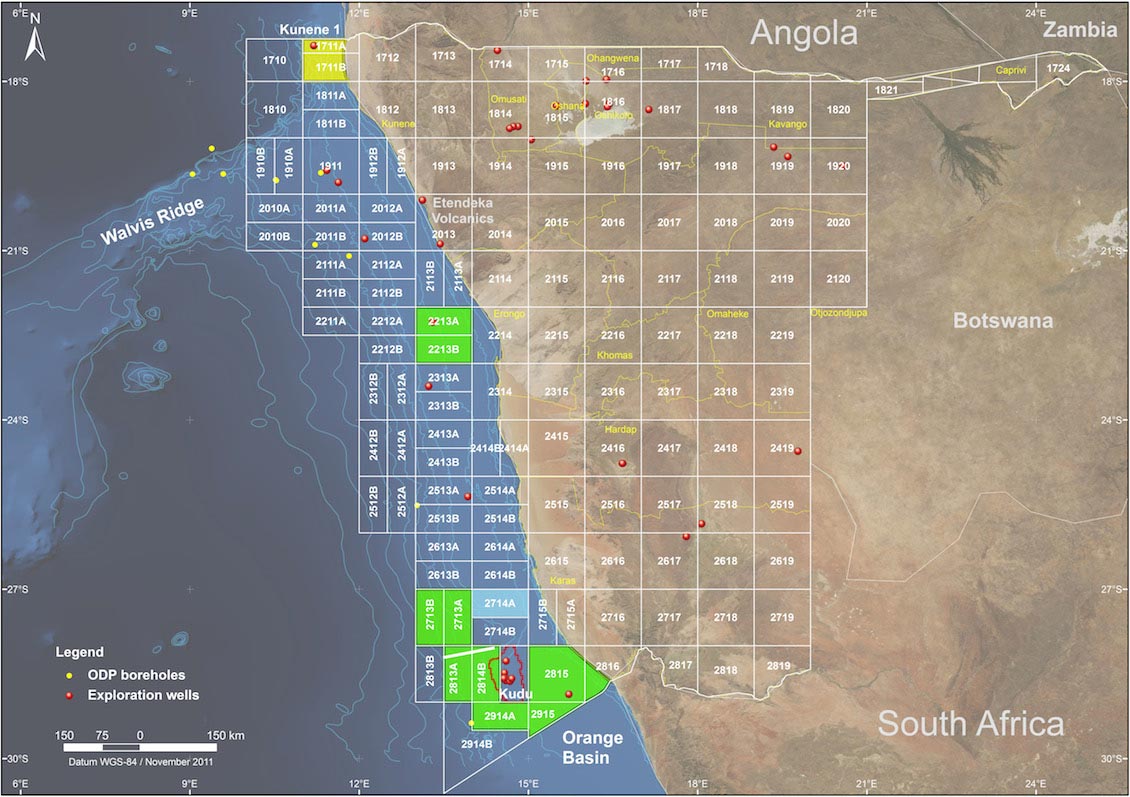
Exploration History
The Namibian continental margin is lo ca ted south of the Walvis Ridge and has been considered a frontier region for oil exploration since the first wildcat, Kudu 9A-1, was drilled in Block 2814A by Chevron in 1974. This successful bore hole discovered a large hydrocarbon accumulation (gas reserves between 1.3 and 3.0 TCF) in Lower Cretaceous sandstones intercalated with volcanic layers.
The Kudu Field lies 130 km from the coastline between Namibia and South Africa in bathymetry less than 200m. Here, aeolian sands constitute the reservoir rocks, which occur at a depth of 4,400m, interbedded with volcanic rocks. The sediments and basalts are dated as Barremian (about 120 Ma), slightly younger than the Etendeka volcanics onshore Namibia (or the Serra Geral flood basalts in the Paraná Basin, Brazil). Seaward-dipping reflector wedges with volcanic layers occur basinwards of a marginal ridge in deep waters. There are multiple reservoirs in the Kudu Field with thickness around 50m and porosity of 12%. The gas accumulation has been evaluated by several appraisal wells but still remains undeveloped.
Since the Kudu discovery, only 14 wells have been drilled offshore; seven of those on the Kudu structure. The remaining exploratory wells failed to find commercial accumulations. Some, however, encountered oil and gas shows in Albian and Aptian reservoirs, as for example, the Walvis Basin boreholes drilled by Norsk Hydro in Block 1911. Up to now, only three boreholes have been drilled in deep water: one by Sasol in 1995, one by Norsk Hydro in 1998, and the Kunene well drilled by Sintezneftegas Namibia in 2008, all of them shallower than 700m. Other companies with past exploration activity offshore Namibia include Arcadia, Enigma, Pancontinental, Ranger, Sasol, Chevron, Shell and BHP. In recent years, HRT, Petrobras, and BP have been active in the area, attracted by the similarities of tectonic evolution and petroleum systems for the basins formed during the Gondwana breakup in the Mesozoic.
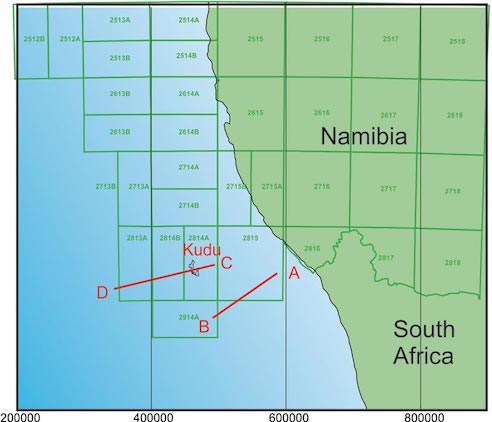
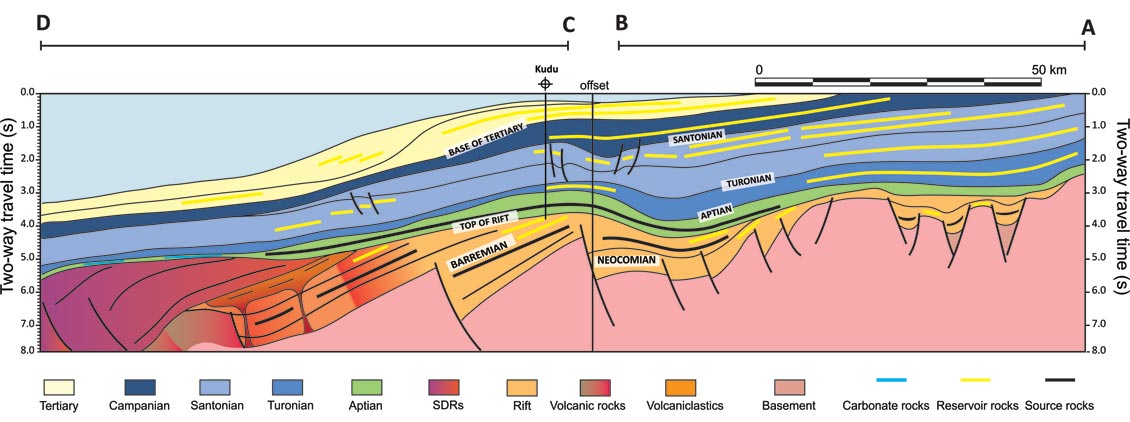
Geochemical Basin Comparison
Plate reconstructions are very important to define regions with equivalent tectonic elements. In terms of exploratory plays, the explorationists aim to predict situations where one recognized prospect, such as the Tupi (now known as Lula) pre-salt discovery offshore Brazil, should be investigated on the other side of the ocean along the conjugate margin. This also implies that a reasonable fit between conjugate segments of the margins would conform to other stratigraphic, structural and geochemical constraints for specific situations.
Past reconstructions have used various mathematical fittings which resulted in unrealistic gaps from north to south and possibly missing key paleoenvironmental links. HRT Oil and Gas geoscientists have applied a new approach in conjugate basin comparisons based on high resolution biomarkers and compound specific isotope similarities between condensates from the Kudu and 2815/15-01 wells and oil and condensate samples from boreholes drilled along the Espirito Santo, Campos, and Santos margin. These geochemical components suggest that the lacustrine and marine source rocks that are extremely prolific in the Brazilian margin north of the Florianópolis Fracture Zone/Rio Grande Rise (and north of the Walvis Ridge) might also occur south of these tectonic elements, in deep water regions offshore Namibia. Aptian source rocks in Kudu wells may reach up to 3% in total organic carbon, whereas the occurrence of very rich Cenomanian to Santonian type II kerogen source rock intervals (up to 6% TOC) are reported in the boreholes drilled in Block 1911 (Walvis Basin).

South Atlantic conjugate margin basins. Source: GetechThe integration of biological markers and high resolution geochemical data from oils and condensate recovered from the exploratory boreholes offshore Namibia indicates two oil systems in the basin. One is characterized by black oils, in the early oil window stage, sourced by Albian-Cenomanian, marine calcareous mudstones. The second is characterized by highly cracked, very mature oils and condensates sourced by a lacustrine saline, alkaline, calcareous black shale deposited in a lacustrine brackish to saline anoxic depositional environment. Both of these oil types are recognized in the Brazilian margin north of the Rio Grande Rise (Greater Campos Basin), with the lacustrine Aptian/ Barremian petroleum system responsible for 90% of the oil generated. The marine Albian/Cenomanian petroleum system has been identified from only a few wells in the south-eastern Brazilian margin.
The implication here is that simply matching conjugate margin basins, for example the Pelotas Basin off Brazil, with the Orange Basin off Namibia, does not necessarily yield the entire story. There is a great deal of contrasting sedimentary development (explained in the next section) from basin to basin and margin to margin. The application of detailed geochemical analyses and integration of geological and geophysical methods can lead to better exploration models for these basins.
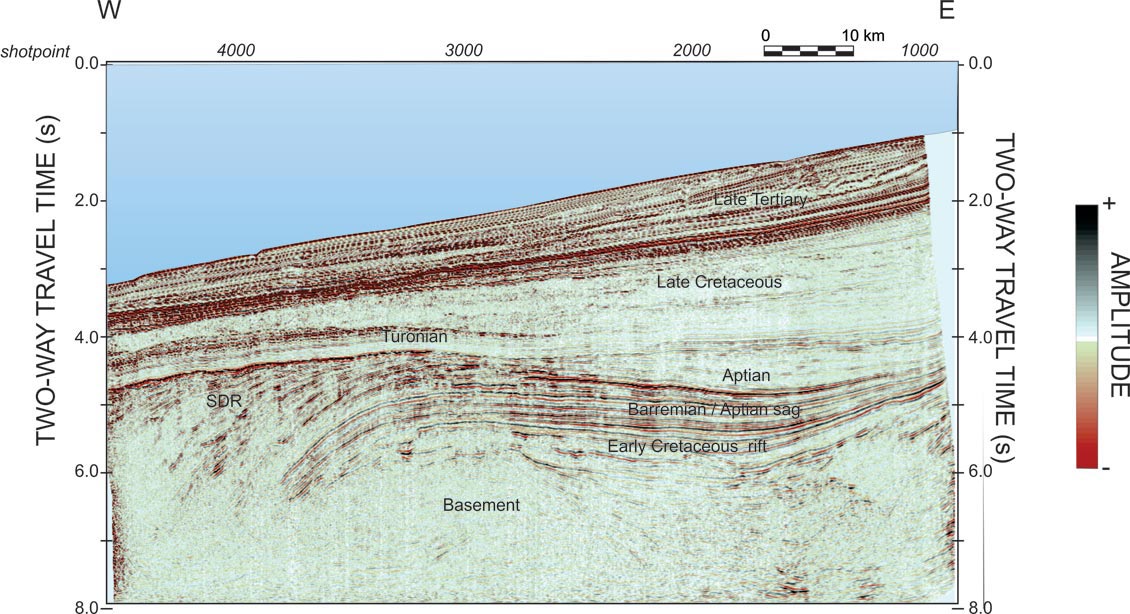
A robust basin analysis evaluation is based on the interpretation that rifting and continental breakup were diachronous and asymmetric, and there are major differences in margin characteristics from basin to basin. For example, it is accepted that the Gondwana breakup started in the southernmost South Atlantic (offshore Argentina/South Africa), probably associated with the Bouvet plume in Africa, by mid Jurassic times. It then advanced to the Pelotas/Santos (offshore Brazil) and Walvis/Namibe (southern Angola) Basins with the emplacement of the Tristão da Cunha plume in the Early Cretaceous, which also formed one of the largest igneous provinces in the world, the Paraná- Etendeka basalts. During the evolving extensional phase, rifts formed along the border of these margins and were filled with continental sediments. Anoxic intervals in Neocomian, Barremian, and Aptian times resulted in the deposition of the extremely rich source rocks that are essential to the petroleum systems that control the occurrence of giant oil fields in the Brazilian and West African margins.
Petrobras has drilled several dry boreholes in the Brazilian conjugate margin to Namibia (Pelotas Basin). There are major Tertiary depocenters along the Brazilian margin, whereas in the African (Namibian) side, the age-equivalent sedimentary sequences are much thinner, indicating a very asymmetric subsidence profile during the development of the margins and contrasting clastic inputs from the highlands onshore. In the Namibian side, the Upper Cretaceous sequences are very thick, suggesting an earlier maturation for the Lower Cretaceous source rocks as compared to the Brazilian side. Another element to distinguish between the two sides of the South Atlantic is that the continental rift developed asymmetrically between Brazil and Namibia. The Pelotas Basin is characterized by proximal rifts in shallow water, and although some geoscientists have suggested the occurrence of a wide and very thick rift in deep waters, this has only been confirmed in the African side. The flip-flop of rift depocenters in conjugate margins (and even salt basins, as is the case with the Santos–Benguela Basins) has clearly a major impact in the exploration strategies.
Applying high-resolution technologies such as geochemistry with biomarker identification of oils and source rocks, we can infer that the environments that existed in the Greater Campos Basin (with Late Aptian salt overlying continental lacustrine rocks) might also have occurred in the southernmost segment of the continental margin, before the first marine ingressions.
The Moosehead giant prospect
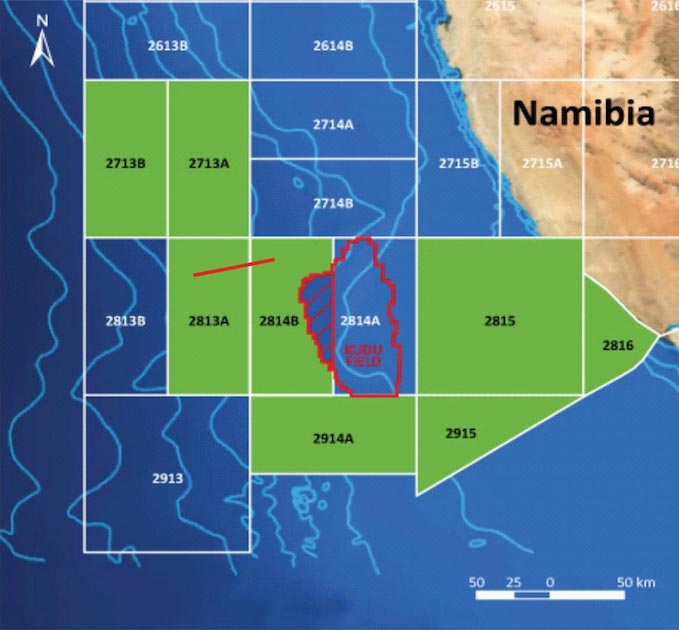

The Moosehead giant prospect, located in Block 2813A, north-west of the Kudu field, shows an intriguing geometry where Turonian turbidites drape over Albian to Aptian carbonate sediments, with possible Aptian carbonate buildups (microbiolites) overlying the outer high. The anticlinal structure is marked by bright and dim spots which might be associated with hydrocarbons. (A) is a regional map of the blocks offshore Namibia near the Kudu discovery; (B) is the structural map for the Turonian reservoir top; (C) and (D) are seismic displays illustrating the geophysical signature and amplitude anomalies of the Turonian turbidite complex and the Aptian carbonate play.
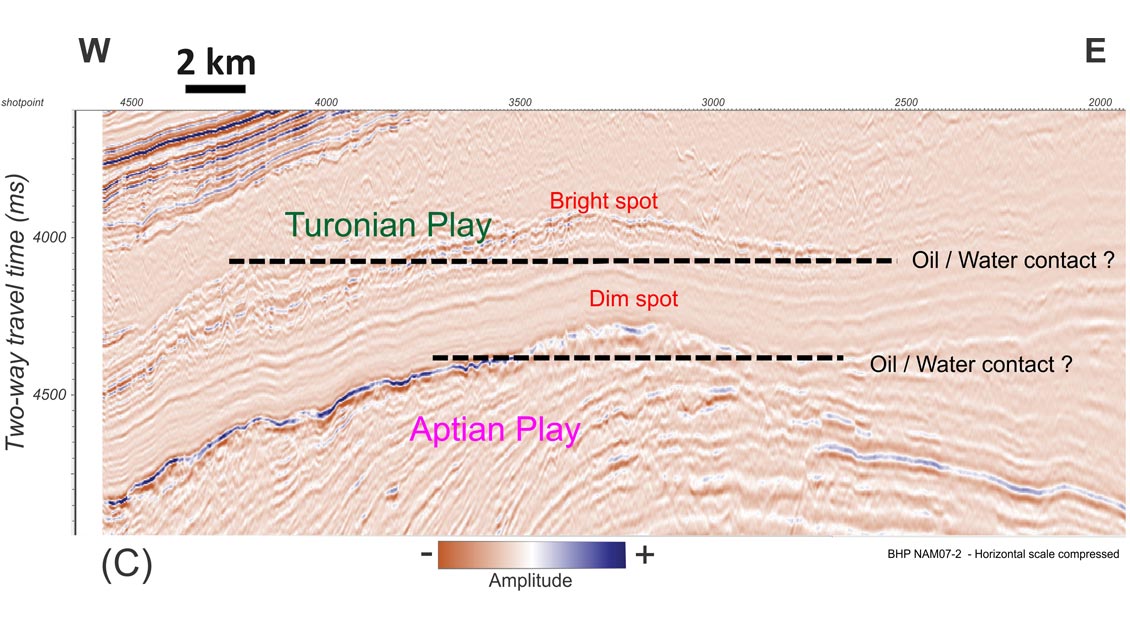
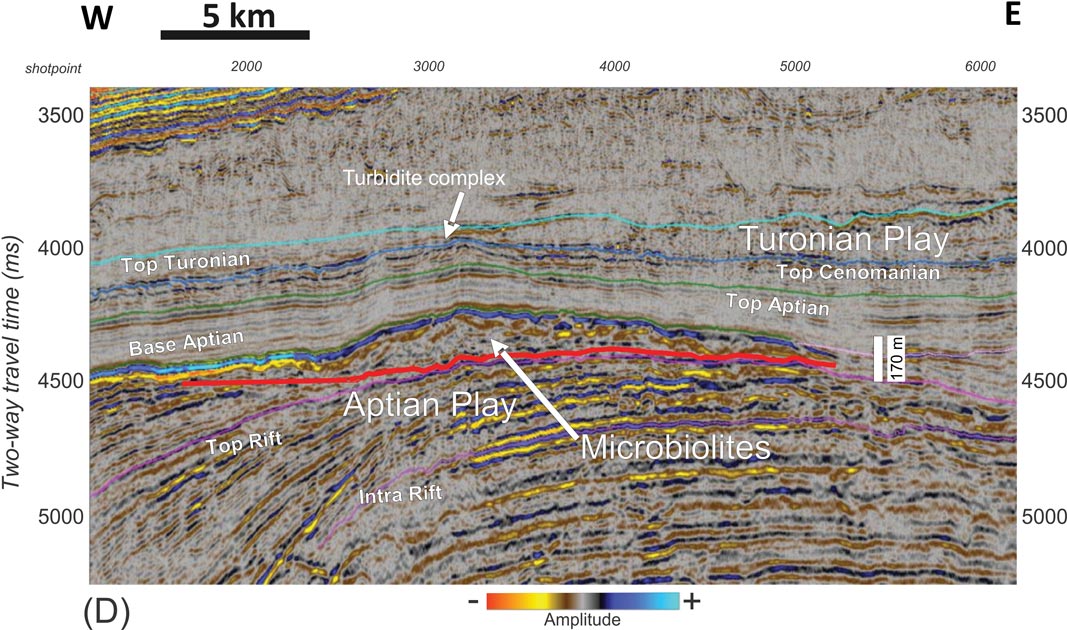
Untested Large Prospects
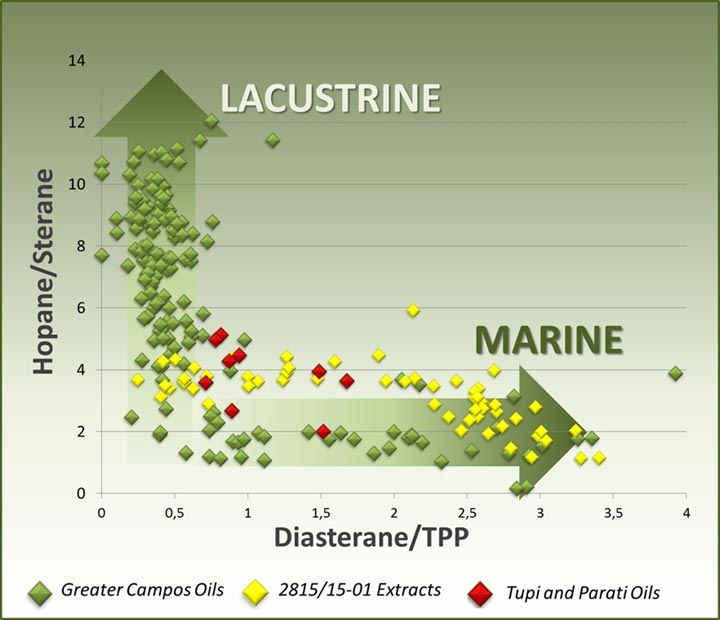
High Resolution Biomarker plot show ing biomarker ratios (Hopane/Sterane plotted against Diasteranes/TPP) distinguishing and correlating lacustrine and marine oils from wells in the Greater Campos Basin, offshore Brazil, and Orange Basin, offshore Namibia. As can be observed, there is a very good correlation among marine and lacustrine oils (e.g. Tupi Field) from the Greater Campos Basin and hydrocarbons recovered from Kudu and 2815/15-01 wells in Namibia. Such data indicates that similar source rock systems are present in both areas. Source: HRTNew and improved seismic imaging of the stratigraphic and structural plays has helped to identify new prospects along the entire Namibian margin. The new seismic has also helped to demonstrate why some of the past wells were failures as well as identifying additional targets in Aptian to Late Cretaceous reservoirs.
HRT-Participações is the holding company of HRT Oil and Gas which currently holds twelve blocks offshore Namibia. HRT will start drilling four of their prospects in the Walvis (Blocks 2112B and 2212A) and Orange (Blocks 2713A and 2813A) basins by late 2012. The most important of them is the Moosehead prospect, involving the Aptian and Turonian plays, which is located in water depths ranging from 1,000m to 1,500m. This is the largest prospect mapped by HRT, with a mean area of about 1,880 km2, and has carbonate reservoirs estimated to contain over 4 Bbo. The possible occurrence of carbonate mounds on top of rift blocks might constitute one major play in the Namibian margin. If successful, the reserves in this prospect alone could reach almost the size of the Tupi discovery, the largest field to date in the Santos Basin, which has a potential size over 4-8 Bbo in water depths of 2,000m, and lies below a salt layer about 2,000m thick.
In July 2011, Pancontinental was awarded an exploration license covering more than 17,000 km2 in the Walvis Basin (Blocks 2012B, 2112A, 2113B), with prospects mainly involving ponded basin floor turbidites and other siliciclastic reservoirs in slope fans and channels. These targets are probably sourced by a restricted graben trough, which nonetheless might contain Early Cretaceous source rocks with high total organic carbon content. And in October 2011, COWAN Petroleum obtained a license covering around 10,000 km2 in the Orange Basin (Blocks 2613A and 2613B), just north of the Moosehead giant prospect. The blocks present prospects mainly involving Cretaceous turbidite confined channels, basin-floor fans (unconfined turbidites), carbonate platform plays, toe thrusts (turbidite-sourced sand bodies affected by compressional tectonics), rift structural plays linked with basement highs and rift graben stratigraphic pinchouts.
Integrated Approach
The outlook for the Namibian offshore has benefited from an exploratory methodology based on the integration of high resolution geochemistry and new seismic imaging into traditional basin modeling. This, and the lessons learned from past exploration, has resulted in a better evaluation of risks and the selection of viable prospects even in this lightly explored area.
The next two years will mark a return to this frontier region, which was left aside for several decades while neighboring and conjugate margin basins witnessed a flourishing period with many giant discoveries. Diamondoid and biomarker analysis of oil and condensates from the Kudu and 2815/15-01 wells proves that the Orange Basin off Namibia contains similar source rocks to its neighbors to the north and across the Atlantic. Over the next few years, drilling should test innovative approaches and hopefully extend production to the Namibian continental margin.





